Physical Address
304 North Cardinal St.
Dorchester Center, MA 02124
Normal eyelid apposition and movement are necessary to provide ocular surface wetting and protection.
Lash–globe contact will result in corneal irritation and breakdown of the corneal epithelium.
Eyelid malpositions such as floppy eyelid syndrome may be associated with other ocular (e.g., NAION and keratoconus) or systemic abnormalities (e.g., obstructive sleep apnea).
Normal eyelid apposition, blinking, and closure are necessary for maintenance of a healthy ocular surface. In addition to protecting the eye and preventing evaporative loss of surface moisture, the eyelid sweeps away lipid-contaminated mucin and allows a new layer of mucin to coat the cornea with every blink. The hydrophilic mucin allows for a stable aqueous tear film. Patients with abnormalities of eyelid apposition or closure will develop breakdown of the mucous layer, leading to inadequate surface wetting and subsequent ocular surface pathology.
The term “entropion” describes an inward rotation of the tarsus such that the keratinized eyelid margin, skin, and lashes directly rub against the globe. Without treatment, entropion can lead to keratoconjunctivitis, corneal abrasion, ulceration, and visual loss. In “ectropion,” the eyelid margin is everted away from its normal apposition to the globe, resulting in chronic epiphora, conjunctivitis, exposure keratitis, corneal scarring, and perforation. “Trichiasis” refers to the posterior misdirection of eyelashes toward the cornea compared with “distichiasis,” in which the eyelashes originate from the meibomian gland orifices within the posterior lamella. In floppy eyelid syndrome, the eyelid becomes elongated horizontally and can evert during sleep, causing irritation and papillary tarsal conjunctival changes. In eyelid imbrication syndrome, the upper eyelid overlaps the lower during closure.
When open, the normal position of the eyelids intersects the superior and inferior limbus. In eyelid retraction, the lid margin is displaced so that it rests above (in the case of the upper eyelid) or below (for the lower eyelid) the limbus, exposing additional conjunctiva and sclera. This leads to increased evaporation of the tear film leading to ocular surface irritation. Lagophthalmos occurs if the retracted eyelids fail to appose during closure. This results in severe drying and irritation of the exposed ocular surface.
Eyelid malpositions more frequently involve the lower eyelid. The lower eyelid retractor complex originates as aponeurotic expansions of the inferior rectus, which inserts into the inferior fornix, the inferior tarsal border, and the preseptal orbicularis muscle and skin to create the lower eyelid crease. The capsulopalpebral fascia also contains the inferior tarsal smooth muscle, which is more diffusely distributed than Müller muscle. The orbital septum typically joins with the capsulopalpebral fascia 4–5 mm below the inferior tarsal border, before inserting onto the inferior tarsus.
Congenital entropion, although rare, can affect both lower and upper eyelids. Proposed mechanisms of congenital upper eyelid entropion have included direct mechanical pressure in utero or intrauterine dysgenesis of the tarsus (kinked tarsus). On eversion, the posterior tarsus in tarsal kink syndrome demonstrates a large horizontal kinking (scarring) of the tarsus that results in inversion of the lid margin and lashes. Proposed pathophysiology of congenital lower eyelid entropion includes vertical deficiency in the posterior eyelid lamella with or without disinsertion of the lower eyelid retractor muscles, horizontal laxity of the medial and lateral canthal tendons, and facial nerve palsies. Ocular anomalies may also be present. Sires reported a retrospective clinical series of 25 cases of congenital horizontal tarsal kink. The classic presentation was male, Caucasian, diagnosed at 7 weeks of age, bilateral or right sided, and with corneal ulceration in 50% of patients.
Congenital entropion should not be confused with epiblepharon, commonly seen in patients of Asian descent, in which a hypertrophic fold of lower lid skin and orbicularis muscle overrides the lid margin and causes the lashes to rotate inward. Pulling the redundant skinfold down gently can often demonstrate that the underlying eyelid margin is in proper anatomic position. Some patients with epiblepharon, in contrast to congenital entropion, may outgrow the lid malposition as the midfacial bones and soft tissues mature.
Involutional entropion is the most common form of entropion and typically involves the lower eyelids in elderly patients. Several factors in combination can contribute to involutional entropion. Horizontal laxity consists of medial canthal tendon laxity, lateral canthal tendon laxity, and tarsal degeneration. Normally, the medial canthal tendon prevents the inferior punctum from being pulled laterally more than 2–3 mm. Lateral displacement of more than 5 mm toward the limbus may warrant surgical correction of the medial canthal tendon ( Fig. 26.1 ). The “snap back” test is performed by pulling the eyelid down. When released, the eyelid should return sharply to its former apposition against the globe. Failure to do so indicates tarsal attenuation or lateral canthal tendon laxity. The eyelid distraction test is performed by measuring the distance with a ruler from the globe to the eyelid margin when the eyelid is pulled anteriorly from the globe. Distraction more than 6 mm from the cornea would be considered abnormal ( Fig. 26.2 ).
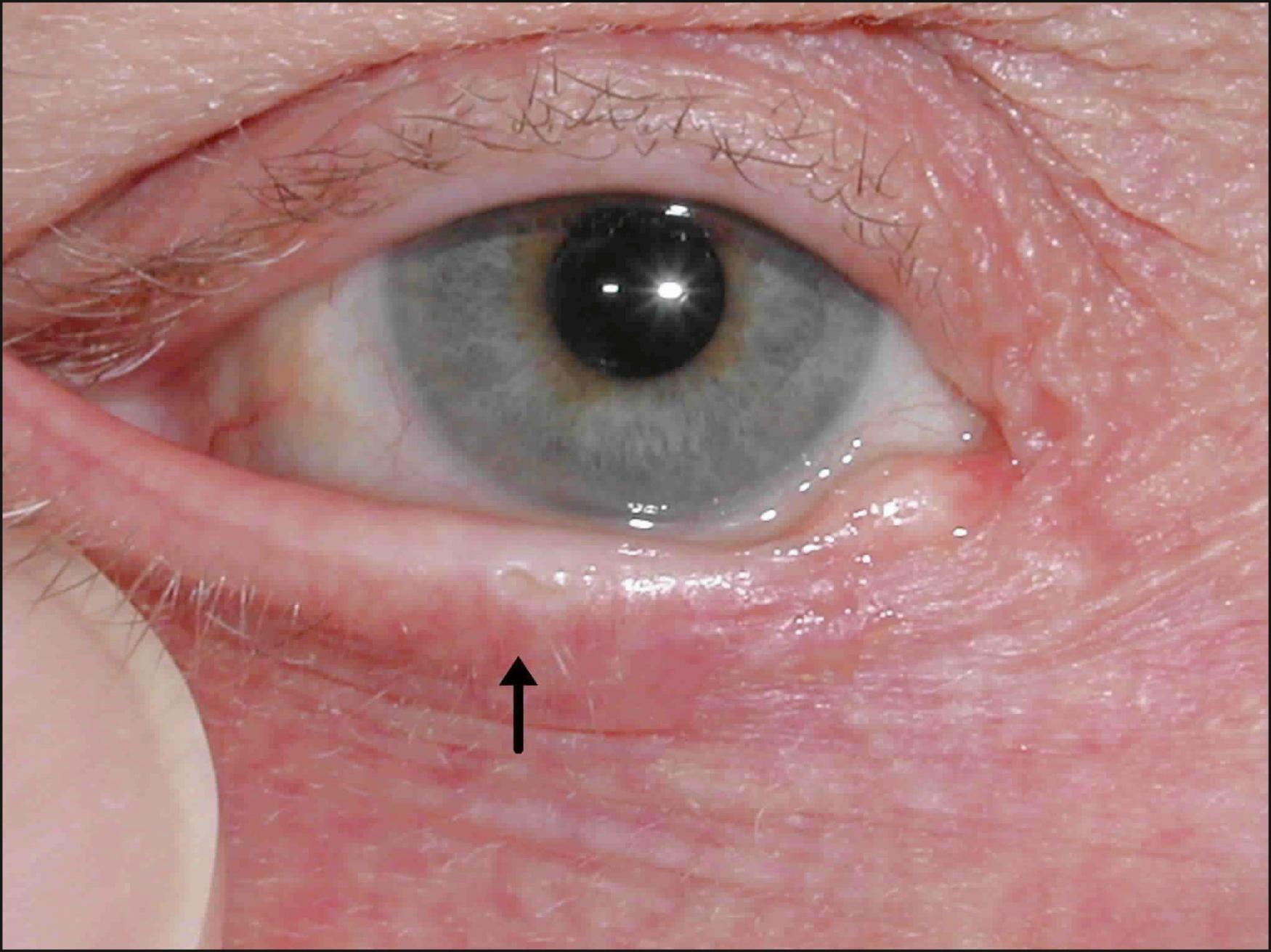
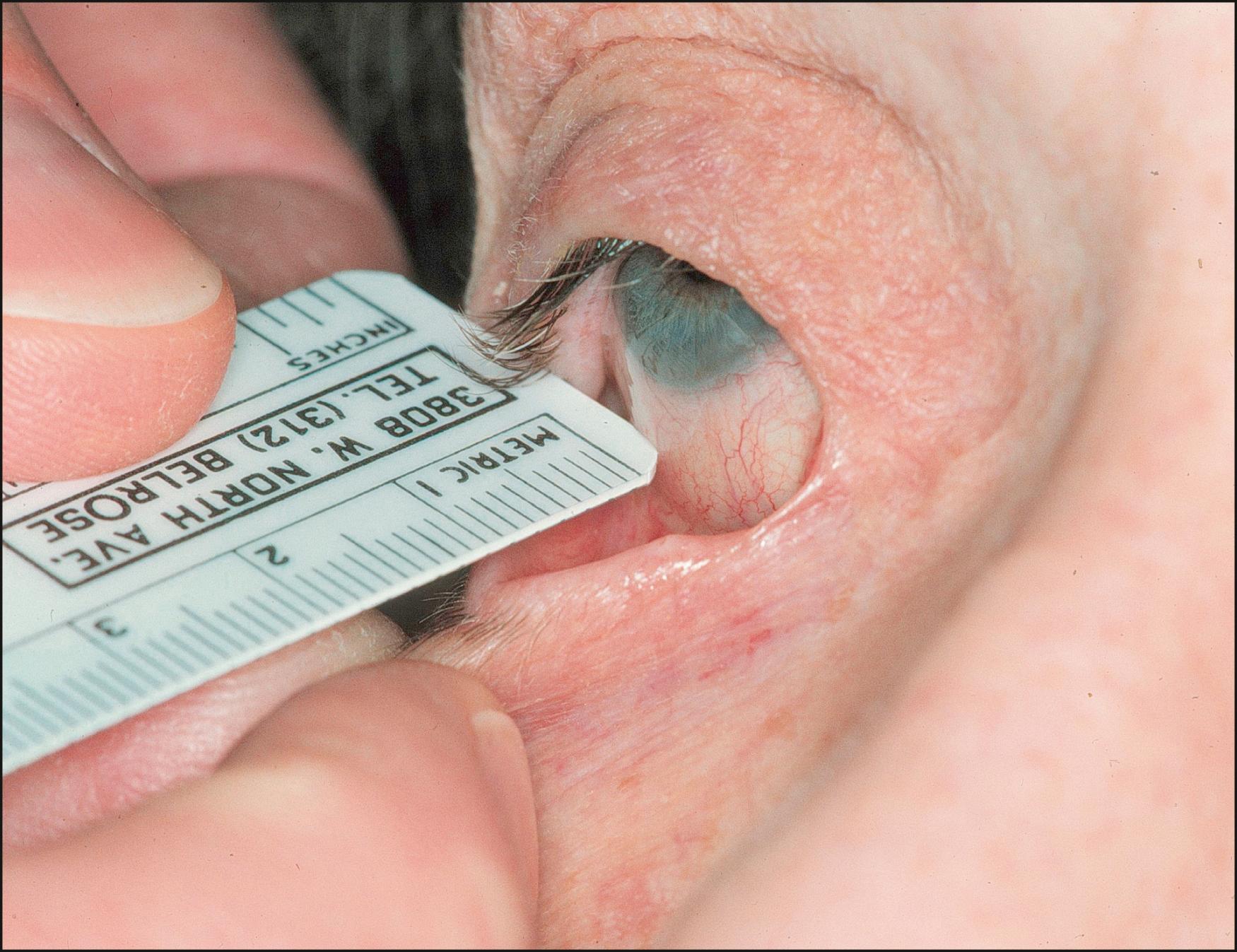
Disinsertion or attenuation of the retractor complex allows the inferior tarsus to move anteriorly and superiorly, causing the eyelid margin to turn inward. A white line corresponding to the leading edge of the disinserted retractor complex may be seen, separated from the inferior tarsus by a pink band that corresponds to the orbicularis visible through the conjunctiva ( Fig. 26.3 ). Because the capsulopalpebral fascial attachment to the inferior fornix remains intact, the inferior fornix may appear deepened when compared with the normal eye. The affected eyelid may also fail to retract inferiorly during downgaze in contrast to an intact lid that retracts in downgaze. It has been often suggested that resorption of orbital fat may further lead to age-related relative enophthalmos and worsened laxity from poor eyelid support.
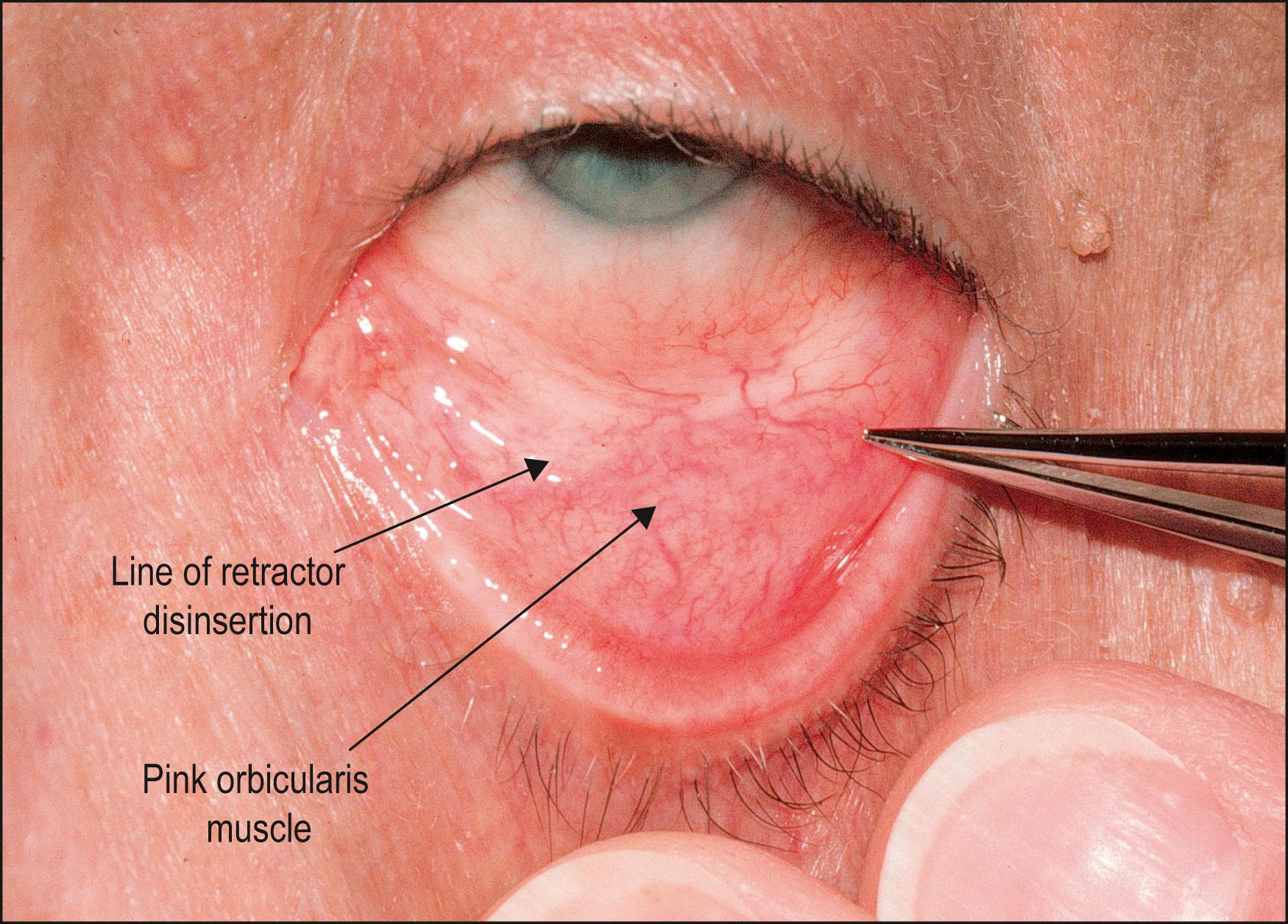
In entropion, a factor that determines whether the unstable lower lid is going to turn inward is the preseptal fibers of the orbicularis muscle overriding the pretarsal fibers. When this occurs, inward pressure is applied to the lid margin. Asians may be more predisposed than Caucasians to involutional entropion due to a more anterior and superior protruding position of orbital fat within the eyelid.
Contracture of the posterior lamella and subsequent entropion may occur secondary to surgical or trauma-related scarring, chemical burns, and inflammatory conditions such as trachoma, Stevens-Johnson syndrome, ocular cicatricial pemphigoid, acne rosacea, and chronic meibomitis. Any long-standing irritation can induce an added cicatricial component to any type of eyelid malposition. Upper eyelid entropion is typically cicatricial in etiology in contrast to the lower lid, in which involutional entropion is most common.
Any ocular irritation (e.g., blepharitis and allergies, following cataract or corneal surgery) can induce significant blepharospasm and subsequent entropion. The eyelids are squeezed tightly such that the orbicularis muscle causes inward rotation of the margin. This condition may resolve after several weeks and can affect any age group. In older patients, it may be a manifestation of a latent involutional entropion.
“Epiblepharon” is a congenital condition that occurs most commonly in Asian patients. The most common presentation is bilateral involvement of the lower eyelids. A thick horizontal fold of eyelid skin and orbicularis is seen overriding the margin, causing the lashes to be pushed backward toward the cornea ( Fig. 26.4 ). In contrast to congenital entropion, the tarsus and posterior margin remain in normal position. The contact of the lashes with the cornea can be present all the time or only in downward gaze. The problem is usually well tolerated because the lashes in children are fine and soft. As the facial bones grow, spontaneous resolution is common, although less often in Asians. Treatment is reserved for cases with significant irritation or a threat to corneal integrity. Similar to the anatomic abnormality in congenital entropion, the anterior insertions of the retractor complex that normally extend through pretarsal orbicularis to insert into the subcutaneous tissues to form the lid crease are absent. This failure to bind skin and orbicularis to the tarsus allows the formation of the horizontal roll seen clinically. Simple excision of the skinfold and strip of orbicularis muscle is frequently performed but does not directly correct the underlying anatomic defect. Quickert-Rathbun sutures may correct the defect by creating a scar between the skin, muscle, and retractor layers and creating a lid crease. Because many Asians do not normally have a lower lid crease, a rotating suture technique with a skin incision just below the lash line and buried sutures may avoid forming a scar and visible eyelid crease.
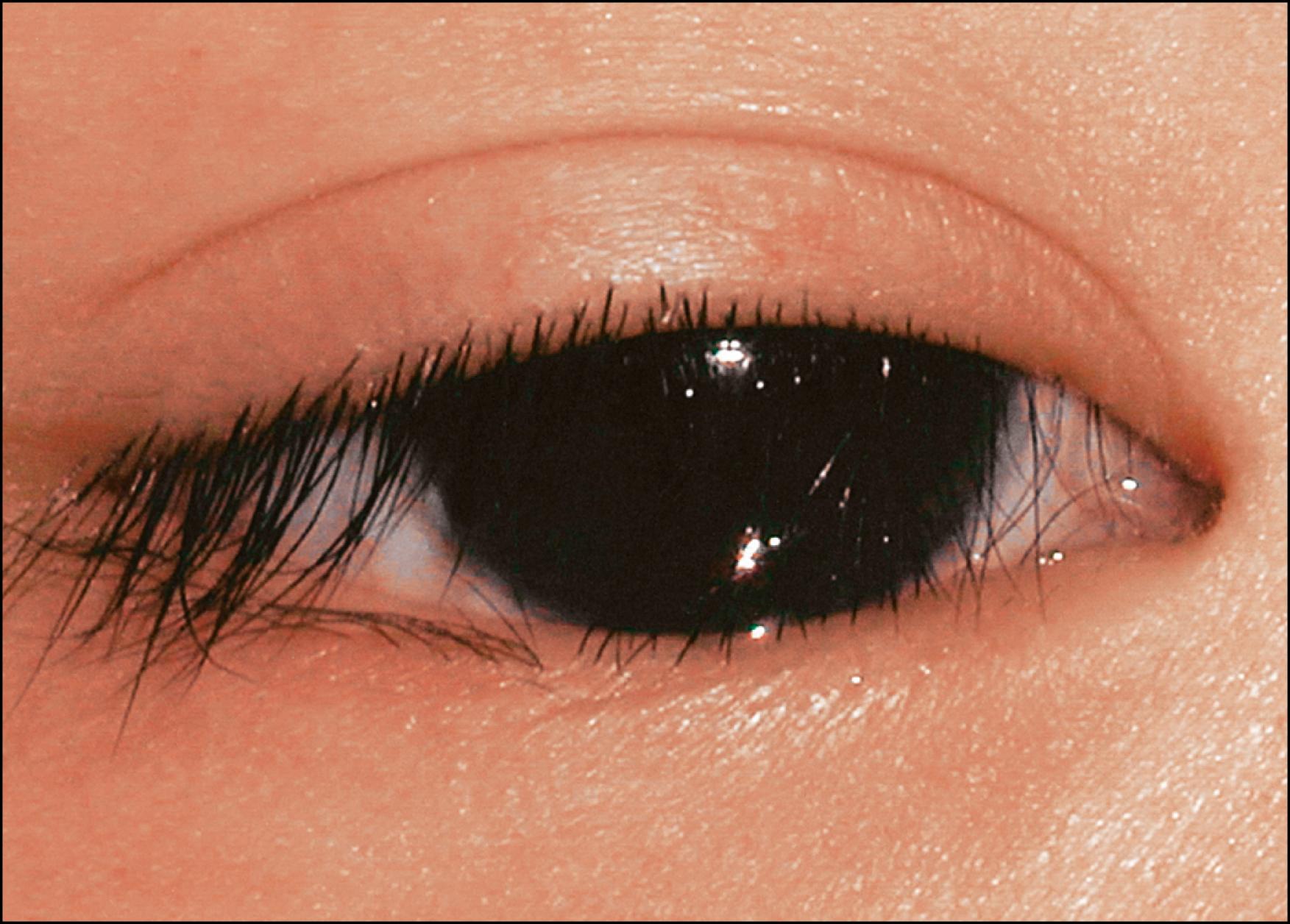
In spastic entropion, conservative management with lubrication, a bandage contact lens, or eyelid taping may break the cycle. Tape is applied near the eyelid margin to pull the margin away from the eye and horizontally and superiorly to simulate a lateral tarsal strip procedure ( Fig. 26.5 ). Tissue glues, such as cyanoacrylate glue, have been placed in the lower lid crease with a 20-gauge cannula to reposition the eyelids successfully. Seven of 10 patients had continued adhesions 1 week after application without ocular complications.
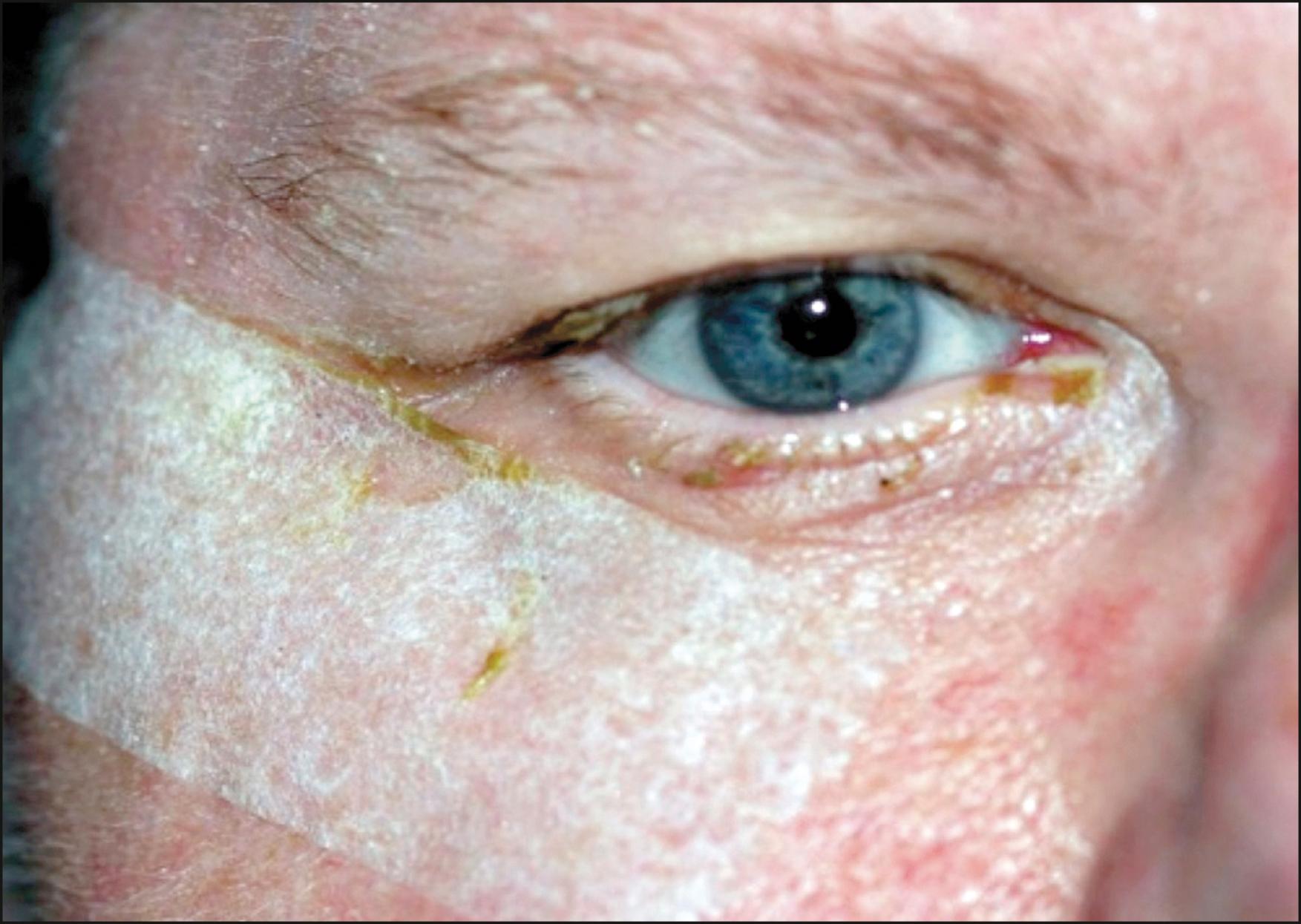
Blepharitis and meibomitis require lid hygiene and antibiotic ointment with or without steroid. Acne rosacea may respond to oral doxycycline. Small injections of botulinum toxin into the orbicularis muscle can be helpful in treating a spastic entropion, with an average duration effect of 12.5 weeks. Complications are few but include ecchymosis, epiphora, and diplopia. However, injection of botulinum can turn an involutional or spastic entropion into a flaccid ectropion if significant lower lid laxity is also present.
The nonincisional suture technique described by Quickert and modified by Feldstein, as well as many others, may be a valuable temporizing measure. One needle of a double-armed 4-0 chromic catgut suture is passed deep into the fornix to secure the dehisced retractors, then passes adjacent to the inferior tarsus and exits higher through the skin at the level of midtarsus. The second needle is passed in the same way 3 mm adjacent to the first. The knot is then tied with enough tension to correct the entropion, without causing ectropion ( Fig. 26.6 ). Three to four sutures can be placed as needed across the eyelid to evert the margin. Resultant subcutaneous inflammatory cicatrix results indirectly in tightening of the retractors to the inferior tarsus and in fibrosis between orbicularis fibers and tarsus that may prevent vertical overriding. Sutures can be removed after 2–3 weeks if not yet resorbed. This procedure is considered temporary due to high recurrence rates, although one study showed that entropion recurred in 15% with only everting sutures after a mean follow-up of 31 months. Scheepers et al. found a high rate of recurrence up to 21% (6/29 patients) with the use of everting sutures alone.
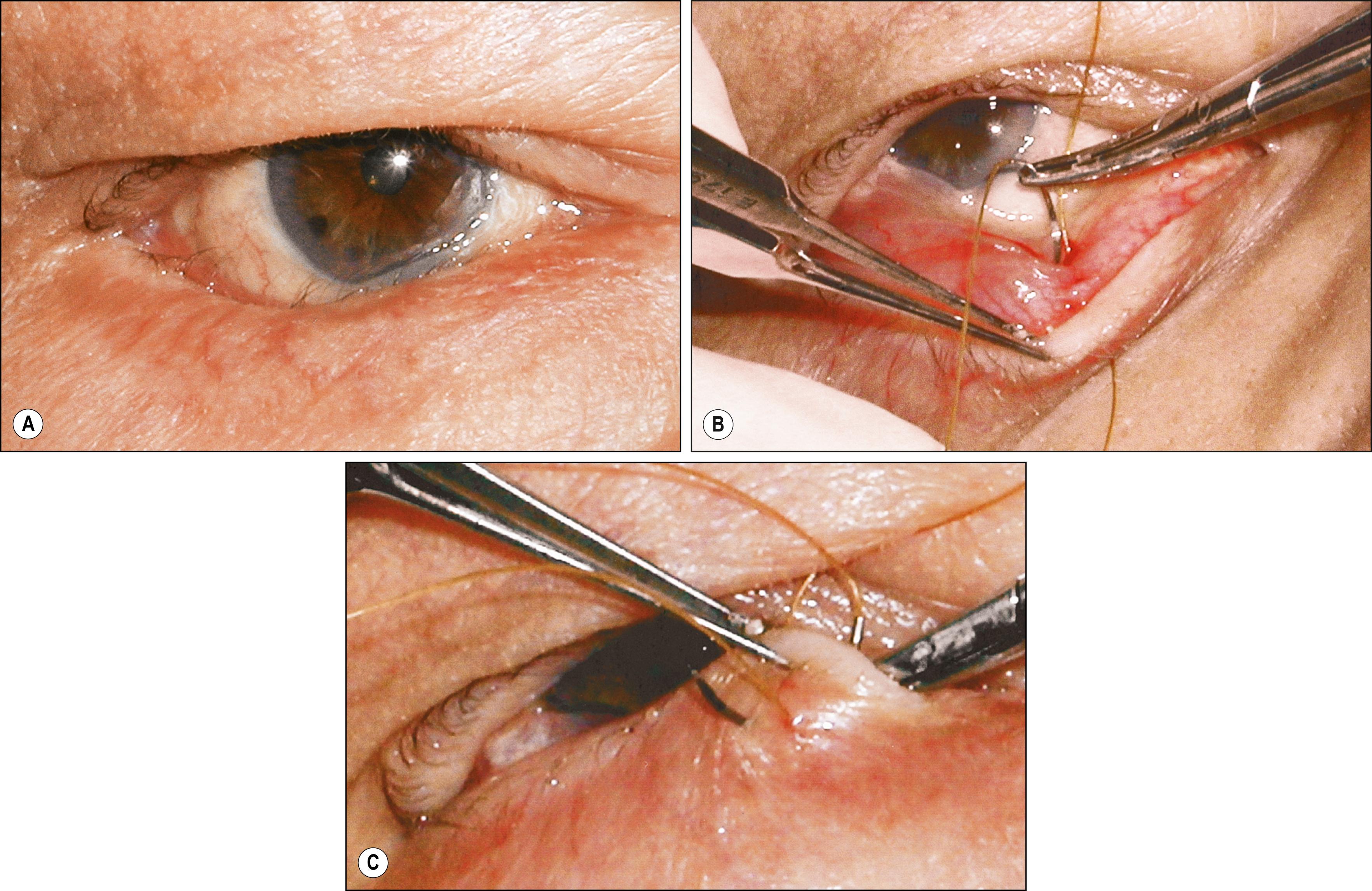
Techniques of surgical correction have included cauterization, temporizing everting sutures, skin and muscle excision, blepharotomy, tarsal incision or splitting, and excision of the kinked area or tarsal fracture with reanastomosis of the retractor complex to achieve better margin apposition. Full-thickness blepharotomy through the upper eyelid at approximately 3 mm above the lash line, with suturing of inferior skin edge to the upper tarsus to rotate the margin, can be useful, and there have been many modifications of this technique in the literature. Intraoperative findings have suggested dehiscence of the normal tarsal–capsulopalpebral fascia attachment in addition to a lack of the cutaneous–capsulopalpebral fascia attachment as in congenital epiblepharon. Thus definitive repair may include attaching both the retractors to tarsus, and skin to tarsus and retractors, in order to correct the lid malposition and create a normal eyelid crease. Price and Collin described an anterior lamellar repositioning technique in which the tarsal kink was corrected by incising the eyelid crease and undermining the skin and orbicularis muscle to the lash roots. 6-0 sutures were passed through the skin just above the lashes and secured higher up on the tarsus to create lid eversion. Additional disinsertion of levator and Müller muscles helped weaken eyelid retraction.
The literature describes numerous anterior and posterior techniques to correct involutional entropion. The anterior approach has a good success rate, although it requires more tissue dissection. , Ideally, either approach should address horizontal laxity, disinserted inferior retractors, and orbicularis muscle override.
Medial canthal tendon laxity is repaired first if present. Plication of the anterior crus of the medial canthal tendon can be addressed via a skin incision, a transconjunctival, or a transcaruncular approach. The medial canthal tendon should be tightened to the periosteum of the posterior lacrimal crest to minimize punctal ectropion, with care taken to avoid injury to the canaliculi and nasolacrimal sac.
Detached or attenuated lower lid retractors should always be reinserted. In the anterior approach, an infraciliary incision is created, and the skin is undermined to the junction of the pretarsal to the preseptal fibers. Dissection then passes through the muscle plane and orbital septum. The detached or attenuated inferior retractors, recognizable by their white color ( Fig. 26.7A ), are reattached to the inferior tarsal border (see Fig. 26.7B ) with absorbable or nonabsorbable sutures (e.g., 6-0 Vicryl).
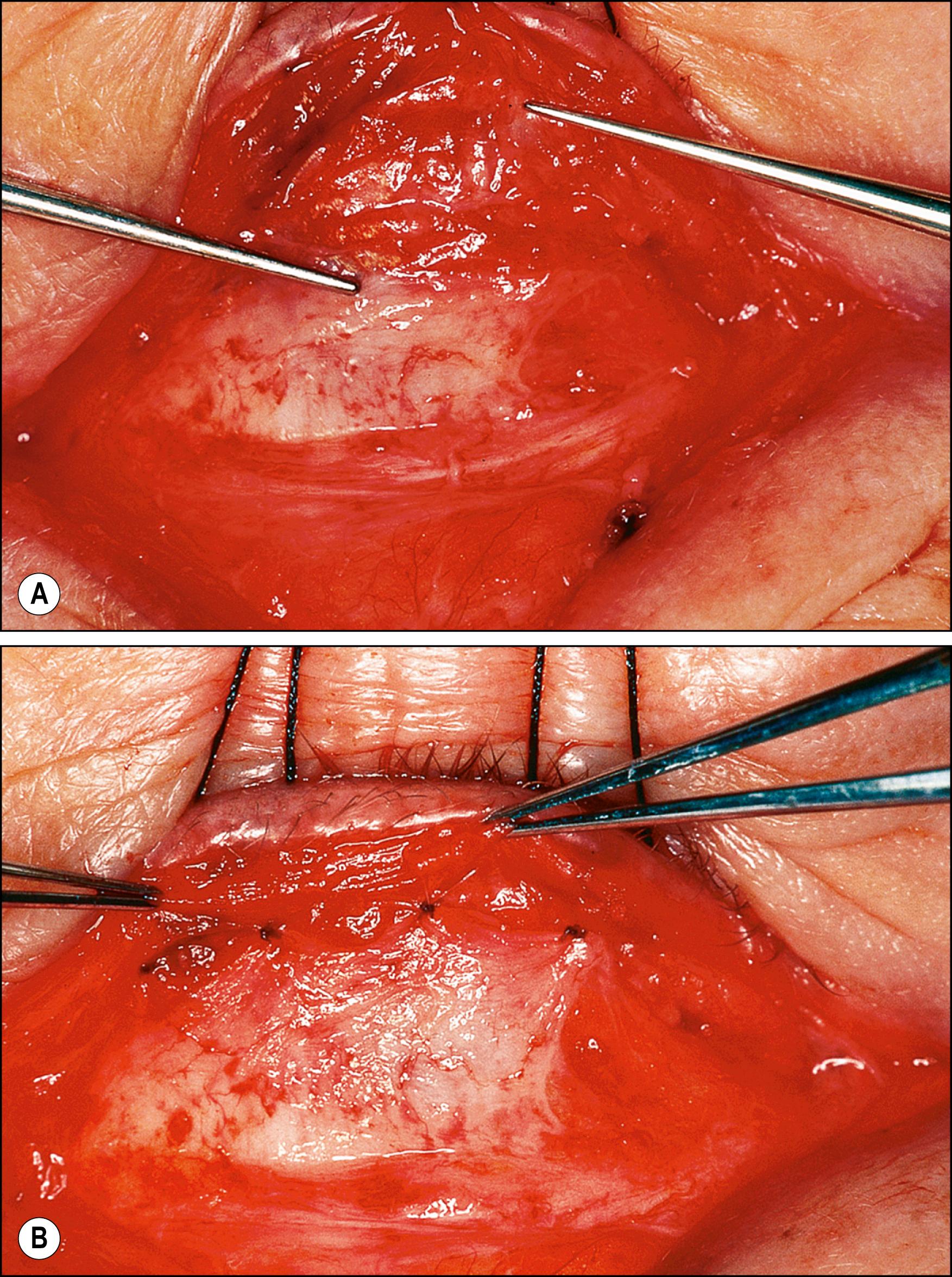
It is important to correct any horizontal laxity with a lateral tarsal strip procedure in order to avoid postoperative recurrence. A lateral canthotomy is performed, and the inferior crus of the lateral canthal tendon lysed. The eyelid is pulled laterally to determine the amount of redundant lid. The eyelid is split into anterior and posterior lamellae, and the tarsal strip denuded of skin, eyelashes, and margin epithelium is anchored to the periosteum inside the lateral orbital rim at Whitnall tubercle using absorbable or nonabsorbable sutures (5-0 Vicryl or 5-0 prolene) ( Fig. 26.8 ). Orbicularis muscle myectomy, performed by excising a narrow horizontal strip of preseptal orbicularis muscle, creates a cicatricial barrier between pretarsal and preseptal orbicularis to prevent orbicularis override.
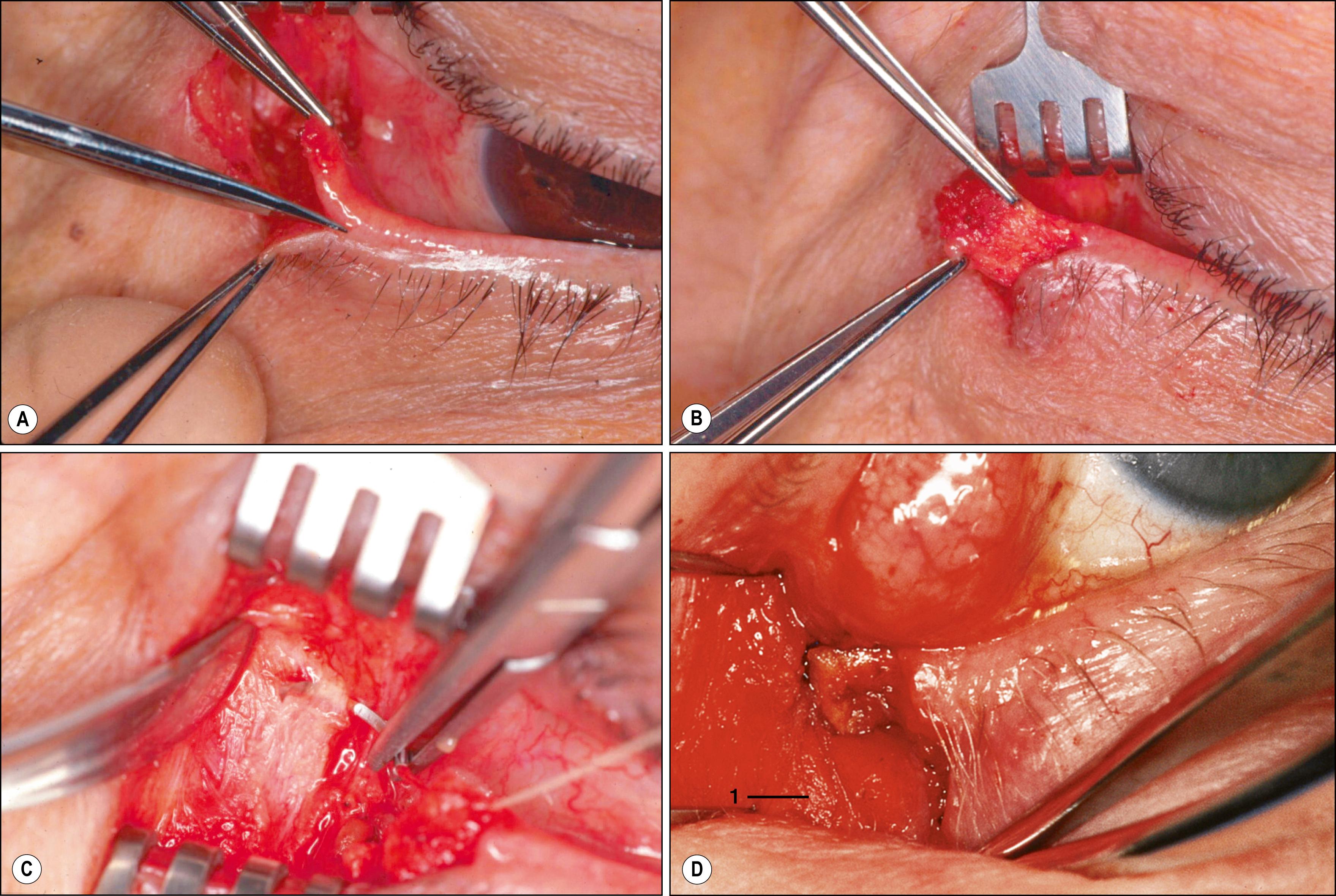
A posterior transconjunctival approach permits all the steps included in the anterior approach without a visible scar and is associated with a recurrence rate of 2%–9%. , , The conjunctiva is incised below the tarsus, and the attenuated retractors are typically identified 5–10 mm below the inferior tarsal border. To reduce the overriding orbicularis muscle, a horizontal strip of muscle is excised with the cautery. The retractor complex is reinserted to the inferior tarsal border with absorbable suture, or the sutures may be passed full-thickness through the lid to be tied on the skin. Horizontal laxity is repaired similarly to the anterior approach.
Before surgery is performed, control of any underlying inflammatory condition is paramount. It is especially important to rule out pemphigoid, since surgical intervention in uncontrolled ocular cicatricial pemphigoid (OCP) may exacerbate the cicatrizing process, potentially leading to severe ankyloblepharon. The severity and extent of posterior lamellar scarring guide the surgical planning. Surgical repair may be considered in three broad categories: margin rotation procedures with a partial- or full-thickness incision through the tarsal plate; eyelid margin splitting procedures with anterior lamellar recession; and procedures that incorporate a spacer graft to elongate the posterior or middle lamella. Mild cases may require only marginal rotation procedures. The transverse blepharotomy and margin rotation described by Weis can be effective in repairing a cicatricial entropion. A full-thickness horizontal incision inferior to the lower tarsal border along the length of the lid is made. Horizontal mattress sutures are then placed through the lower lid retractors, passing anterior to the tarsus, and exiting 1–2 mm inferior to the lash line. In effect, this procedure creates a full-thickness blepharotomy scar between the retractors, tarsus, and the anterior lamella.
Full-thickness tarsal margin rotation with superadvancement of the posterior lamella 2–3 mm past the new rotated margin may allow for contraction to occur without recurrence of entropion. In the upper lid, a full-thickness posterior tarsal incision is made 3 mm superior to the lash line with back cuts at the incision ends in order to rotate the margin. The remaining posterior lamella is advanced past the rotated margin and secured with horizontal mattress sutures. A horizontal V-wedge resection of anterior tarsus has been described to avoid surgery on the conjunctiva that could reactivate an inflammatory disease. Following an eyelid crease skin incision, the tarsus is exposed down to the lashes. A horizontal V-shaped groove within the tarsus is made at the area of the greatest bend. Closure of the groove using 6-0 polypropylene sutures rotates the lid margin outward.
Additional correction can be achieved with shortening or repositioning of the anterior lamella, such as a lid splitting procedure or tarsoconjunctival advancement. Graft materials are often used for severe scarring or retraction of the posterior lamella. Spacer graft sources include buccal mucosa, tarsoconjunctival flaps, amniotic membrane, nasal chondromucosa, ear cartilage, hard-palate mucosa, and synthetic membranes. Hard palate has the appropriate strength for entropion correction and is also flexible and relatively easy to harvest. Swamy and colleagues reported 95% symptomatic improvement using hard palate, with the most common postoperative complications including excess keratin (29%), recurrence (4.1%), punctate epithelial erosion (2.7%), donor site bleeding (2.0%), and graft shrinkage (0.7%).
Acellular grafts, typically composed of flexible collagen-dermal sheets from cadaveric acellular collagen matrix, demonstrate minimal postoperative inflammation and negligible risk of immunologic rejection. These are used to correct cicatricial entropion, secondary to shrinkage of the posterior lamella of the eyelid, by lengthening the deficient tissue without a second morbidity site. Thin 0.3-mm AlloDerm (Life Cell Corp, Branchburg, NJ) grafts were reported to have a contraction rate of 57% compared with hard palate grafts (16%) in a prospective trial of 14 patients undergoing lower lid surgery. A different study using 1.8-mm AlloDerm grafts found their use to be superior to the thin AlloDerm grafts but comparable to hard palate grafts in the reconstruction of the posterior lamella in lower lid retraction. ENDURAGen implants (Porex Surgical, Newnan, GA), which are a porcine acellular collagen matrix typically 0.5–1 mm thick, can also be grafted to the inferior tarsal edge. Complications were reported in 10% of patients, attributed to inadequate spacer size, infection, or excess graft placement.
Become a Clinical Tree membership for Full access and enjoy Unlimited articles
If you are a member. Log in here